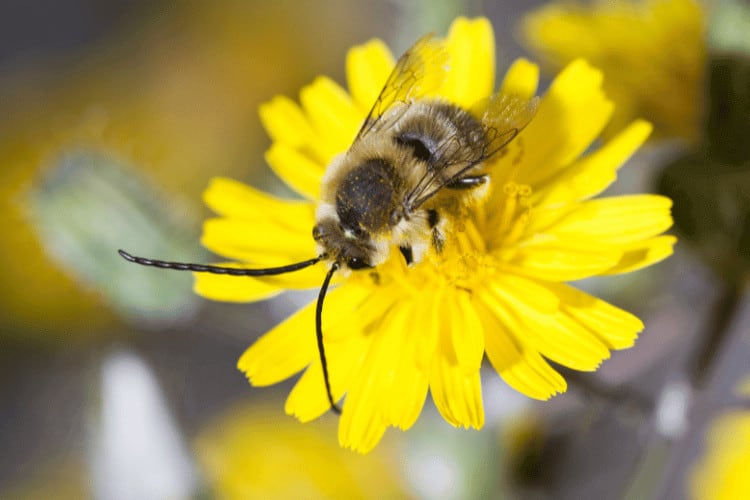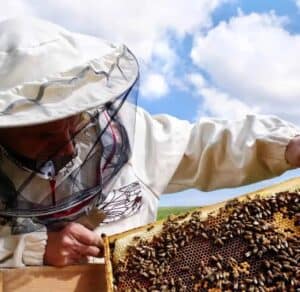Long-horned Bees: The Fuzzy Friends with Long Antennae
Ever seen a bee with antennae so long, they look like they could touch their toes? That’s a long-horned bee! These fuzzy friends are important pollinators, and they’re also pretty darn cute.
I remember the first time I saw a long-horned bee. I was in my backyard, watering the flowers, and this big, fuzzy bee with antennae the size of my pinky finger landed on a nearby flower. I was so surprised! I had never seen a bee like it before.
I got closer to take a better look, and the bee didn’t seem to mind. It just went about its business, pollinating the flower. I was fascinated by this little creature, and I learned a lot about long-horned bees that day.
Description and Characteristics of Long-horned Bees

Long-horned bees are a group of bees in the family Apidae. They’re found all over the world, and there are over 3,000 different species. The most common species in the United States is the Melissodes communis (Cresson).
The color of the hair can vary from species to species, but it is often black, brown, or yellow. Some long-horned bees have bright colors, such as red or orange.
Long-horned bees are named for their long antennae, which can be longer than their bodies. The bodies of long-horned bees are typically covered in hair, which helps to keep them warm.
Typically, the males have longer antennae than the females. The antennae are used to detect the scent of flowers. Long-horned bees also have long tongues, which they use to reach the nectar at the bottom of flowers.
Long-horned bees are solitary bees, which means that each female bee builds her own nest. The nest is typically a burrow in the ground, but some species build their nests in wood or other materials.
What Is a Long-horned Bee’s Purpose?
Long-horned bees are important pollinators, and they can benefit beekeepers in a number of ways.
They Can Help to Pollinate Crops
Long-horned bees are attracted to a wide variety of flowers, including many crops that are important to beekeepers. By pollinating these crops, long-horned bees can help to increase yields and improve the quality of the produce.
They Can Help Control Pests
Long-horned bees are also predators of some insect pests, such as aphids and caterpillars. By helping to control these pests, long-horned bees can help to reduce the need for pesticides, which can be harmful to bees and other pollinators.
They Can Help to Diversify the Bee Population
Beekeepers often focus on a few species of bees, such as honeybees. However, long-horned bees and other wild bees are also important pollinators.
By providing habitat for long-horned bees, beekeepers can help to diversify the bee population and make their apiaries more resilient to pests and diseases.
Long-horned Bees’ Habitat and Foraging Preferences
Long-horned bees are found in a variety of habitats, including forests, meadows, and gardens. They’re most common in temperate regions, but they can also be found in tropical and subtropical regions.
Long-horned bees prefer to forage in sunny areas with abundant flowers. They’re attracted to flowers with tubular blooms, such as lavender, columbine, and snapdragons. They use their long tongues to reach the nectar at the bottom of the flowers.
Some species of long-horned bees are also predators of insect pests, such as aphids and caterpillars. These bees will often visit flowers to collect nectar and pollen, but they’ll also search for insect prey.
Here are some of the long-horned bees’ foraging preferences:
- Flowers with tubular blooms: Long-horned bees have long tongues, so they need flowers with deep blooms in order to reach the nectar. Some common flowers that long-horned bees like include lavender, columbine, and snapdragons.
- Sunny areas: Long-horned bees are active during the day, so they prefer to forage in sunny areas.
- Abundant flowers: Long-horned bees need a lot of food to support their young, so they prefer to forage in areas with abundant flowers.
- Diverse habitats: Long-horned bees are generalist pollinators, so they can be found in a variety of habitats. However, they do prefer habitats with a variety of flowers, so gardens and meadows are ideal.
Where Can You Find Long-horned Bees?
These fuzzy friends can be found all over the world, in a variety of habitats. Here are some of the best places to find long-horned bees

- Gardens: Long-horned bees love gardens, especially those with a variety of flowers. Look for them on sunny days, buzzing around lavender, columbine, and snapdragons.
- Meadows: Long-horned bees also frequent meadows, where they can find plenty of flowers to pollinate.
- Forests: Long-horned bees can also be found in forests, where they often nest in dead trees. If you’re hiking in the woods, listen for the buzzing of long-horned bees, and keep an eye out for them on flowers.
- Drylands: Some species of long-horned bees prefer drylands, such as deserts and grasslands. If you’re in a dryland area, keep an eye out for long-horned bees on flowers that are adapted to dry conditions.
Long-horned Bees’ Life Cycle, Mating, and Nesting
Long-horned bees are fascinating creatures with a complex life cycle. Here’s a closer look at how they grow, mate, and build their nests:
Life Cycle
Each female bee builds her own nest and cares for her own young, with no colony of worker bees to help. The female bee starts by digging a burrow in the ground or in a piece of wood. She then lines the burrow with pollen and nectar, and then, lays a single egg.
The egg hatches into a larva, which feeds on the pollen and nectar. After a few weeks, the larva pupates and eventually emerges as an adult bee.
Mating
Long-horned bees mate in the spring or summer. The male bees will search for females, and the females will choose a mate based on his size and strength.
Once they’re paired up, the male and female will fly together for a short time before mating.
Nesting
Long-horned bees build their nests in a variety of places, including the ground, wood, and even walls.
Importance of Long-horned Bees in Ecosystems and Agriculture
Long-horned bees are beneficial to the environment, and to beekeepers, in so many ways.
- In ecosystems: Long-horned bees help to pollinate a variety of plants, including fruits, vegetables, and nuts.
- For beekeepers: Long-horned bees can be a valuable asset to beekeepers. They can help to pollinate crops, control pests, and diversify the bee population.
- In agriculture: Long-horned bees are important pollinators of many crops, including almonds, blueberries, and cranberries. By pollinating these crops, long-horned bees can help to increase yields and improve the quality of the produce.
Common Questions About Long-horned Bees
What Do Long-horned Bees Eat?
Long-horned bees are attracted to flowers with tubular blooms, such as lavender, columbine, and snapdragons. They use their long tongues to reach the nectar at the bottom of the flowers.
Some species of long-horned bees are also predators of insect pests, such as aphids and caterpillars. These bees will often visit flowers to collect nectar and pollen, but they will also search for insect prey.
Are Long-horned Bees Dangerous?
Long-horned bees are generally not dangerous. They’re not aggressive by nature, and will only attack if they sense hostility.
The long antennae of long-horned bees can make them look intimidating, but they aren’t used for stinging. The antennae are used to detect the scent of flowers.
Still, if you see a long-horned bee, it is best to leave it alone.
What Size Are Long-horned Bees?
The size of long-horned bees can vary greatly, but the average size is about 0.6 inches (1.5 centimeters) long. Here are some of the smallest and largest long-horned bees in inches:
Smallest
- Melissodes agilis: 0.04 inches (1 millimeter)
- Osmia pumila: 0.05 inches (1.2 millimeters)
Largest
- Megachile pluto: 1.2 inches (3 centimeters)
- Megachile pluto var. titan: 1.3 inches (3.3 centimeters)
It’s important to note that these are just averages, and the actual size of a long-horned bee can vary depending on the species and the individual bee.
How to Identify Long-horned Bees?
Long-horned bees are a diverse group of bees, and there are many different ways to identify them. Here are some of the most common features:

- Long antennae: Long-horned bees are named for their long antennae, which can be up to twice as long as their bodies. The antennae are used to detect the scent of flowers.
- Hairy bodies: Long-horned bees have hairy bodies, which helps to keep them warm. The hair can also be used to collect pollen.
- Tubular tongues: Long-horned bees have long tongues, which they use to reach the nectar at the bottom of flowers.
- Color: Long-horned bees can be a variety of colors, including black, brown, yellow, and orange. Some species have bright colors, while others are more muted.
- Pattern: Some long-horned bees have distinctive patterns on their bodies, such as stripes or spots. Others have a more uniform coloration.
How to Attract Long-horned Bees?
Here are some tips on how to attract long-horned bees to your yard:
- Plant a variety of flowers. Long-horned bees are attracted to a variety of flowers, so it’s best to plant a variety of different types.
- Plant flowers that bloom throughout the season. This will ensure that there is always food available for long-horned bees.
- Provide water. Long-horned bees need water to drink and bathe. You can provide water for them by placing a shallow dish of water in your yard.
- Avoid using pesticides. Pesticides can kill long-horned bees and other pollinators. If you must use pesticides, choose ones that are labeled as “bee-friendly.”
- Create a bee-friendly habitat. This could include providing nesting materials, such as hollow logs or straw, and creating a sunny spot with bare ground for the bees to build their nests.
Conclusion
Long-horned bees are found all over the world, and there are over 3,000 different species. They’re attracted to flowers with tubular blooms as well as any blossoming plant.
The fuzzy Long-horned bees are important pollinators, and they play a vital role in our ecosystem. They help to pollinate many of the plants that we eat, such as fruits, vegetables, and nuts.
Long-horned bees are declining in many parts of the world due to habitat loss and pesticide use. We can help to protect long-horned bees by planting native flowers in our gardens, avoiding using pesticides, and creating bee-friendly habitats.

Joseph Davis
My goal is to show that anyone can take up beekeeping and it can be a very rewarding hobby. I strive to share my experiences and answer any questions you may have.
